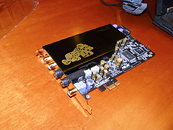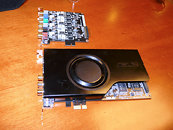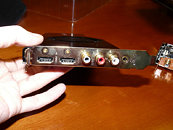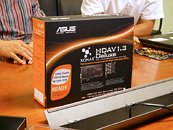- Joined
- Oct 9, 2007
- Messages
- 47,853 (7.38/day)
- Location
- Dublin, Ireland
| System Name | RBMK-1000 |
|---|---|
| Processor | AMD Ryzen 7 5700G |
| Motherboard | Gigabyte B550 AORUS Elite V2 |
| Cooling | DeepCool Gammax L240 V2 |
| Memory | 2x 16GB DDR4-3200 |
| Video Card(s) | Galax RTX 4070 Ti EX |
| Storage | Samsung 990 1TB |
| Display(s) | BenQ 1440p 60 Hz 27-inch |
| Case | Corsair Carbide 100R |
| Audio Device(s) | ASUS SupremeFX S1220A |
| Power Supply | Cooler Master MWE Gold 650W |
| Mouse | ASUS ROG Strix Impact |
| Keyboard | Gamdias Hermes E2 |
| Software | Windows 11 Pro |
ASUS has sensed that there is a sizable market for discrete high-end sound cards, and is now out to grab its share. There are primarily two kinds of high-end sound card segments: gamer-grade and audiophile-grade. ASUS has created a new sound card to cater to each segment, though there could be more SKUs carved out of these sound card designs. The gamer-grade card, called Xonar Essence. From what the picture vaguely shows, the card continues to use the AV200 audio chipset, also seen is the bus translation logic, made by PLX. The card uses PCI-Express x1, though interestingly, requires that you collect a Molex connector to fuel it. It is said to carry industrial-grade Japanese capacitors. The portion of the card that houses vital DAC/ADC circuitry is covered by a fancy EMI shield. It is said that this card comes with a signal to noise ratio of 124 dB.
On with the audiophile card, ASUS has introduced the Xonar HDAV series sound cards. There are two cards: HDAV 1.3 and HDAV 1.3 Deluxe, depending on the presence of a daughter-card that expands the card's connectivity. The card uses RCA connectors for both digital and analog outputs. It also features two HDMI 1.3 ports for both output and input (for recording/mastering), is HDCP compliant and allows audio pass for protected Blu Ray content. The Xonar Essence awaits launch while Xonar HDAV 1.3 has been launched, and product page published. Pictures (in order) for Xonar Essence, Xonar HDAV 1.3 Deluxe, its connectors and package are provided.




View at TechPowerUp Main Site
On with the audiophile card, ASUS has introduced the Xonar HDAV series sound cards. There are two cards: HDAV 1.3 and HDAV 1.3 Deluxe, depending on the presence of a daughter-card that expands the card's connectivity. The card uses RCA connectors for both digital and analog outputs. It also features two HDMI 1.3 ports for both output and input (for recording/mastering), is HDCP compliant and allows audio pass for protected Blu Ray content. The Xonar Essence awaits launch while Xonar HDAV 1.3 has been launched, and product page published. Pictures (in order) for Xonar Essence, Xonar HDAV 1.3 Deluxe, its connectors and package are provided.




View at TechPowerUp Main Site
Last edited:





 ). The average joe would have to purchase adapters. Kinda crazy to have the individual channels on a daughter card, though.
). The average joe would have to purchase adapters. Kinda crazy to have the individual channels on a daughter card, though.